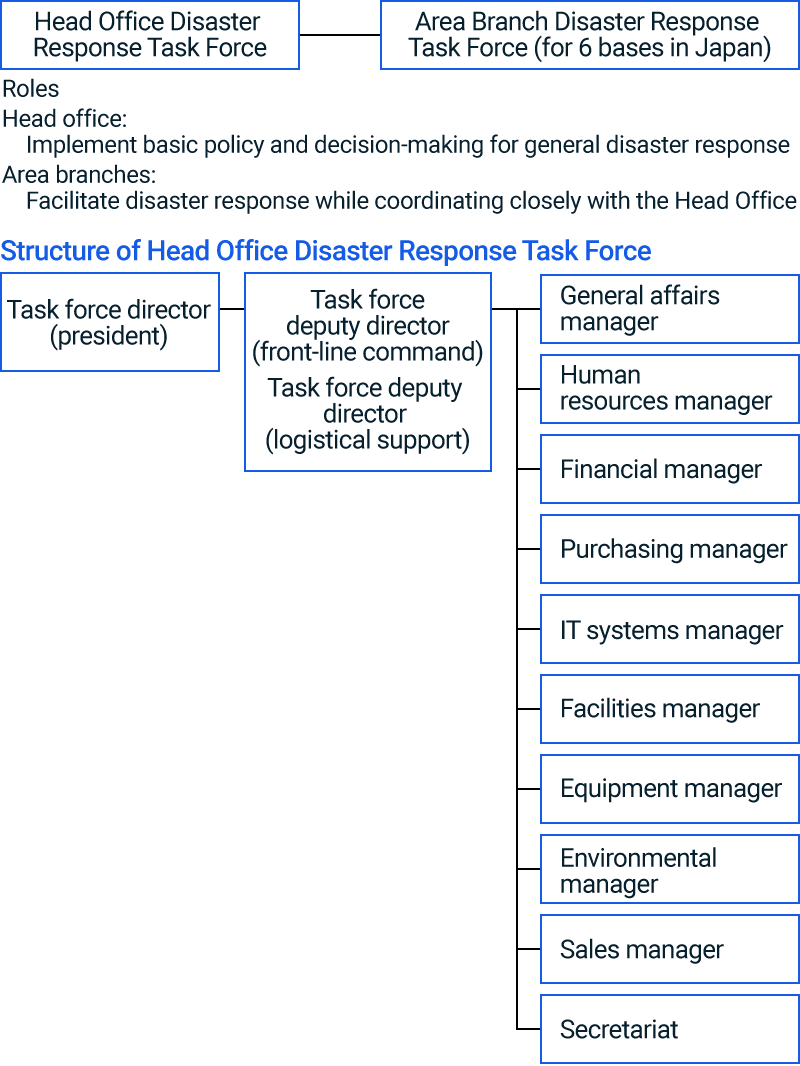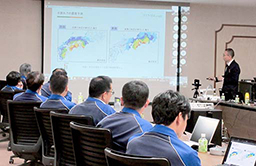Risk Management
Risk Management Policy
Our Group reviews business risks on a periodic basis, based on our policy on internal control, and takes the necessary steps to manage such risks. In cases involving any business risks that are deemed significant, responsible divisions or specialized committees formulate regulations and guidelines, conduct training, prepare manuals, and undertake additional activities as deemed necessary.
Business Risks
| Risk | Description | Possibility | Impact | Response | ||||||||||||||||||||||
| 1. Risks related to procurement of materials and other items | Limited supply or delays for raw materials and fuels, or rising prices of such materials or logistical costs | Medium | Large | Maintain good relations with suppliers, find new suppliers, increase the number of suppliers, and switch to general-purpose materials. | ||||||||||||||||||||||
| 2. Risks related to natural disasters, accidents, and outbreaks of communicable disease | Suspension of operations or delays in production and shipments caused by natural disasters such as earthquakes, typhoons, and heavy rains, or accidents such as fires and power outages, or outbreaks of infectious disease (including such occurrences in the supply chain); and costs to repair damage to facilities | Medium | Large | Implement a business continuity plan, provide seismic reinforcement of structures, implement disaster preparedness measures, arrange dispersed manufacturing sites, and prevent the introduction and spread of communicable diseases. | ||||||||||||||||||||||
| 3. Risks related to information security | Claims for damages due to the leaking of confidential information that the NEG Group obtained in the course of business, or tarnished corporate reputation due to such problems; and the suspension of business activities or information systems operation due to a computer virus or cyberattack | Medium | Medium | Establish an Information Management Committee, establish a Computer Security Incident Response Team (CSIRT), carry out incident response drills, deploy security systems, and provide in-house training | ||||||||||||||||||||||
| 4. Drastic changes in demand and market structure | Contracted demand for existing products due to technological innovation, or fluctuation of price or supply of products due to intensified competition | Medium | Medium | Speed up R&D, respond to new needs through aggressive sales. | ||||||||||||||||||||||
| 5. Capital expenditure risks | Significant change in demand forecast, shortage of plant capacity, sudden change in price of major equipment or materials | Medium | Medium | When and however necessary, build new production facilities and continuously upgrade them. | ||||||||||||||||||||||
| 6. Environmental risks | A shift to stricter environmental regulations, or more corporate responsibilities related to the environment demanded by society | Medium | Medium | Develop environmentally friendly products, ensure that facilities and management systems exert minimal impact on the environment, raise production efficiency, practice the 3Rs (reduce, reuse, recycle), strengthen efforts to reduce carbon emissions, and promote disclosure based on TCFD recommendations. | ||||||||||||||||||||||
| 7. Risks related to legal restrictions | Violation of the laws or regulations of the country or region where we operate | Medium | Small | Comply with laws and regulations, survey changes in legal revisions, and hold periodic in-house education and audits. | ||||||||||||||||||||||
| 8. Risks related to fluctuations in currency exchange rates and interest rates | Fluctuations in currency exchange rates and interest rates | Medium | Small | Utilize forward exchange contracts, properly manage interest-bearing debt, and secure partial financing of fixed-interest-rate loans. | ||||||||||||||||||||||
| 9. Risks related to the sales of certain products | Change in investment or sales plan or material procurement policy of our major customers | Low | Large | Diversify our customer base. | ||||||||||||||||||||||
| 10. Risks related to overseas business operations | Unanticipated changes in laws or regulations; international tax risk; particular trade practices; changes in political or social conditions; and social turmoil due to terrorism, war, outbreaks of infectious disease, or other factors | Low | Medium | Facilitate close communication between overseas subsidiaries and local authorities, and get advice from experts. | ||||||||||||||||||||||
| 11. Risks related to labor and securing human resources | Difficulty in securing appropriate human resources for future business development and labor-related compliance violations | Low | Medium | Secure an optimal and effective workforce through active recruitment and training of diverse personnel, achieve labor saving through automation and other means, and institute labor management according to laws and regulations. | ||||||||||||||||||||||
| 12. Risks related to intellectual property rights | A litigation related to intellectual property rights | Low | Medium | Obtain intellectual property rights useful for business, survey and monitor other companies’ intellectual property rights, develop alternative technologies, and take over or license intellectual property from other companies. | ||||||||||||||||||||||
Implementing BCP
Implementing BCP
To be prepared for disasters such as earthquakes, typhoons, floods, fires, and mass infections, we created a disaster management manual based on the company’s disaster preparedness regulations, and we carry out emergency drills periodically. In the wake of the 2011 Great East Japan Earthquake, we reviewed our disaster management measures and implemented seismic reinforcement to our buildings, production facilities, and equipment.
In 2015, we began using business continuity planning (BCP), which replaced the previous disaster preparedness regulations. To facilitate the processes necessary for BCP, we created a manual providing information on detailed preparation procedures and actions that should be taken when an emergency or disaster strikes. In accordance with the implementation of BCP, we have also introduced a system that will efficiently confirm the whereabouts of all domestic employees and their families in case of an emergency. Moreover, in order to resume production and continue to supply our customers in the aftermath of a disaster, we are working to strengthen our procurement-related risk management system.
BCP Activation Structure

BCP Basic Policy
-
Protect each employee and their families and secure their safety
-
Protect production equipment, prevent the spread of damage as well as secondary disasters from occurring within the company and the adjacent communities, and help with rescue efforts
-
Resume providing customers with products and services as rapidly as possible
BCP Response Training

At our BCP response training carried out in November 2024, we conducted a drill focused on responding to the issuance of Nankai Trough Earthquake Extra Information and, from this, were able to identify response-related issues.
Preparing for Computer Security Incidents
Every year, ransomware and other types of cyberattacks are becoming more advanced and sophisticated. The number of companies being affected is also growing, presenting an increasing risk to business.
We are working to strengthen the risk responsiveness of our systems, organization, and individuals. In addition to our existing training and education for employees, we maintain a Computer Security Incident Response Team (CSIRT) and have created a manual for responding to computer security incidents. CSIRT conducts regular training activities to prepare for a possible incident.